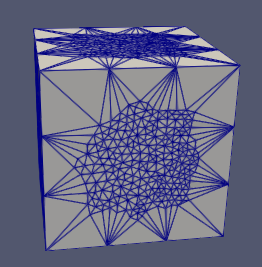edge_size cannot be null:
In the documentation of the constructor CGAL::Mesh_criteria_3< Tr >::Mesh_criteria_3, it is said:
edge_size: a scalar field (resp. a constant) providing a space varying (resp. a uniform) upper bound for the lengths of curve edges. This parameter has to be set to a positive value when 1-dimensional features protection is used.
In your Python example, you can use edge_size=Field(), and it will have the effect you want, I think.
 Note that the triangles incident to the sharp edges have one edge on the sharp edge that is slightly smaller than the rest of the mesh, but their two other edges have edge lengths similar to the triangles that are not-incident to sharp edges.
Note that the triangles incident to the sharp edges have one edge on the sharp edge that is slightly smaller than the rest of the mesh, but their two other edges have edge lengths similar to the triangles that are not-incident to sharp edges. Then the edges on the sharp edges have roughly the same size as the other ones, but the two other edges of triangles incident to sharp edges are bigger.
Then the edges on the sharp edges have roughly the same size as the other ones, but the two other edges of triangles incident to sharp edges are bigger.
I would like to create a mesh with variable cell size, and only the cell size, not edge size, angles etc., should influence the mesh. (See https://github.com/nschloe/pygalmesh/issues/114.) This is using pygalmesh, but the underlying issue in in CGAL.
Setting the
edge_sizeto0.0does not work:Fair enough. Let's set it to some really large value (which is the default, too). Result:
This isn't good either, as it seems that the cell size is not respected at the edges.
In pygalmesh, the mesh criteria are set as